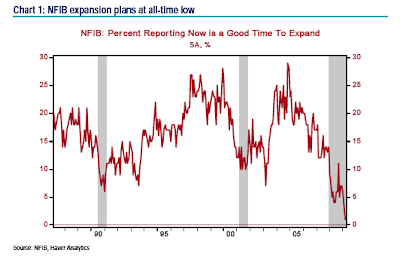Small business optimism sinks to a new lowGreen Shoots Questioned
The NFIB index for March was released yesterday. This is a monthly survey of small business sentiment and it declined for the fourth month, in a row to 88.7 from 90.4 in February. The last time it was this low was back in April 1980. While it was inflation and not deflation that was public enemy #1 at that time, we seem to recall that the next sustainable economic expansion and bull market were, oh, only more than two years away.
The NFIB leads real GDP growth by 1-2 quarters with a near-60% historical correlation. And, in terms of the top concerns facing small businesses today, 31% cited “poor sales” while a mere 6% referenced “inflation”. Somehow this finding would augur well for an overweight in bonds and an underweight in equities in the asset allocation decision.
Small business plans to expand slid to a mere 1% in March from what were already microscopic levels in January and February (6% and 3% respectively). Capex plans were also trimmed to their lowest levels since 1975 – to 16% in March from 18% in February. So, without business spending, and without the consumer or housing that at best will likely flatten once the downturn ends, the only areas left that can possibly sustain a renewed and sustainable expansion would seem to be exports and government spending.
The economics community seems convinced that the production cuts to date have been sufficient to offset the plunge in business sales. Yet there is ample survey data suggesting that companies on an aggregate basis are still uncomfortable with their current levels of stockpiles. The NFIB survey actually showed that inventory plans fell to their lowest level in 34 years in March (to -13 from 10). The last time the NFIB inventory plan number was this low there was an $11 billion inventory withdrawal in the ensuing four quarters that ended up shaving almost 2 percentage points (annualized) from real GDP.
For all the talk of ‘green shoots’, they seem to have bypassed the most important market of all, which is the market for jobs. The NFIB job openings index inched lower in March to 10 from 11 in each of the previous two months to stand at its lowest level since November 1991. If memory serves us correctly, a sustained and robust recovery – one that is usually confirmed by a bear market in Treasuries – was at least two years away. And, in the 35-year history of the series, the hiring intentions component, at -10, has never been as low as it is today.
We are being told that credit conditions are easing and there is actually no doubt that spreads have been tightening, though in many cases they still remain in the stratosphere. While there has been buoyant debt issuance activity, bank lending is actually contracting at a record rate and this is where most small businesses secure their financing.
Rosenberg is not the only one questioning those "green shoots". Please consider Green Shoots over Thin Ice by John Hussman.
In recent weeks, the financial markets have taken enormous hope from economic data that has outpaced depressed expectations – generally only slightly, but uniformly enough to encourage investors that the “green shoots” of recovery are in place.Hussman is always a great read whether I agree with what he is saying or not (I usually do). In this case I echo his sentiment exactly. Please read Hussman's piece in entirety for some great historical observations by Richard Russell and how they relate to today.
Careful. We've seen a nice bounce to clear an oversold condition, coupled with the very ordinary “ebb and flow” of economic data that periodically offers intermittent relief even in the worst economic downturns. What we haven't seen to any real extent is “revulsion.” Quite to the contrary, investors have frantically bid up the worst credits – distressed financials, homebuilders, and heavily leveraged cyclicals, while the percentage of bullish investment advisors has quickly surged above the percentage of bearish advisors.
Fundamentally, my view is that the U.S. economy is on very thin ice, and that by focusing on the bailout of corporate bondholders rather than the restructuring of debt, we are courting the risk of a far deeper downturn. Last year, I didn't think it was conceivable that policy-makers would attempt to address this problem by making lenders whole with public funds. This is an ethical abomination, putting the public in the position of absorbing the losses that should properly be borne by those who provided capital to these institutions. It is not sustainable. What it does is place the public in the position of losing first, but it will not, and cannot prevent the ultimate failure of the debt – for the simple reason that without restructuring, the debt can't be serviced.
As Harvard historian Niall Ferguson observed last week, “Only somebody who studies financial history could say, as I was trying to say, ‘Look, something as big as the liquidity crisis of 1914 or as big as the banking crisis of 1931 is imminent.' We don't really have a great many options here. If we stay the present course, you're going to see the tailspin continue. To be effective, a large-scale restructuring of household indebtedness would need to be mandatory. The Great Depression was initially a U.S. financial crisis. But what made it a depression was its global contagion, and then the breakdown of trade and the retreat into protectionism. All of that can happen. All of that is in fact happening with terrifying speed.”
Mike "Mish" Shedlock
http://globaleconomicanalysis.blogspot.com
Click Here To Scroll Thru My Recent Post List

Không có nhận xét nào:
Đăng nhận xét